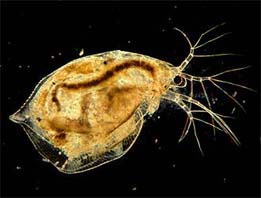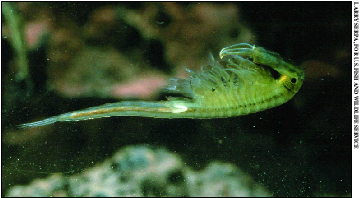

Left: A mirrored right lateral view of Daphnia magna, courtesy of www.splash.org
Right: A right lateral view of a fairy shrimp, courtesy of U.S. Fish and Wildlife Service


Left: A mirrored right lateral view of Daphnia magna, courtesy of www.splash.org
Right: A right lateral view of a fairy shrimp, courtesy of U.S. Fish and Wildlife Service
The Branchiopoda consist of four living groups: the Anostraca ("fairy shrimp" or "sea monkeys"), Notostraca ("tadpole shrimp"), Cladocera ("water fleas"), and Conchostraca ("clam shrimp'). There are also two fossil groups that belong to the Branchiopoda, but it is unresolved whether they are subgroups within the living groups or evolved separately. Here the fossil groups will be discussed within the living groups to which they are most similar.
With almost 800 described species, it is difficult to generalize about the branchipods. Most live in fresh or brackish (slightly salty) water and a few are found in marine habitats. Many are found exclusively in temporary ponds, where their eggs survive long periods of drought. You often find packages of dried eggs for sale in pet and toy stores. When the eggs are placed in water with an airstone, they hatch in just a couple days and you can watch them grow and swim. They are often used as food for aquarium animals.
It is even more difficult to generalize about the body form of branchiopods. The thorax and abdomen are fused or indistinguishable in most but the Anostraca. Their appendages are generally phyllopodus (leaf-like), although some groups have more appendages than others. They have a combination of paired compound and/or a single simple median eyes. Many are capable of parthenogenesis (growing from unfertilized eggs) but several use other reproductive strategies, ranging from releasing eggs when the adult molts to encapsulating the eggs in a modified molt.
Branchiopods feed in many ways. Some suspension feed and either remove organic particles from the water as they swim or stir up sediments to suspend organic particles that have settled and then remove them from the water. Others scrape organic matter from sand grains and rock. Still others actively prey on other small animals.
The most familiar member of the Anostraca are Artemia. They have elongate bodies compared to most other living branchiopods, with leaf-like appendages that they use to swim belly up. One centimeter is the average size for adult anostracans but some species will reach as much as 10 cm. Anostracans completely lack a carapace. The extinct group Lipostraca is often joined with the Anostraca. The Lipostraca consist of one species, Lepidocaris rhyniensis Scourfield, 1926, found in a very unusual fossil formation, the middle Devonian Rhynie Chert of Scotland. Fossils from this deposit are found in chips and nodules of silica thought to have precipitated from a silica saturated hot spring or geyser pool. If the habitat that these silica fossils were formed in was indeed a hot spring, it is not surprising that Lepidocaris rhyniensis is the only animal that is abundant in the deposit.
The Notostraca are called "tadpole shrimp" because of their broad, plate-like carapace and narrow, elongate thorax/abdomen. When populations are very large, Triops, a well known notostracan, can cause considerable damage to rice paddies by burrowing into the sediment and inadvertantly dislodging the young shoots. Notostraca has only 9 species, considerably fewer than any other branchiopod groups. The species are rather similar to each other and practically indistinguishable from extinct fossil forms. A fossil group often paired with the Notostraca are the Kazacharthra, found only in Jurassic rocks of Kazachstan, a country that neighbors Afganistan. They differ from notostracans by the shape of their carapace, which has elaborate spines on the margin giving them a rather fierce appearance.
Cladocerans are called "water fleas" and are typically quite small ranging from one half millimeter to three millimeters (however, oone species reaches up to 18 mm). The best known member of the Cladocera is Daphnia. The carapace of cladocerans covers the throrax/abdomen but not the head, and is folded down the midline giving them a bivalved appearance. Cladocerans dominate the plankton found in freshwater habitats. The cladocerans are mostly benthic but those that do swim, do so with their antennae instead of their thoracic appendages. The few cladoceran groups that occur in marine habitats are very different, having huge eyes and instead of being filter feeders like most of their freshwater relatives are active predators.
The Conchostraca or "clam shrimps" differ from the Cladocera in three primary ways: 1) They have appendages along the entire thorax/abdomen whereas the appendages are found only on the anterior segments of cladocerans. 2) Their carapace is bivalved with a hinge that allows opening and closing of the two halves. The cladocerans' carapace, on the other hand, is a single piece that wraps around the animal to cover the animal. 3) The conchostacan body is completely enclosed in the carapace but the head (cephalon) of cladocerans is not covered by their carapace. Conchostracans are found exclusively in freshwater.

Sources:
Scourfield, D. J. 1926. On a new type of crustacean from the Old Red Sandstone - Lepidocaris rhyniensis. Phil. Trans. Roy. Soc. Lond. (B)214: 153-187.
Tasch, P. 1969. Branchiopoda. In: Treatise on Invertebrate Paleontology. Part R. Arthropoda 4. R. C. Moore ed. Geological Society of America, Inc. and Univ. of Kansas. 1: 128-191.